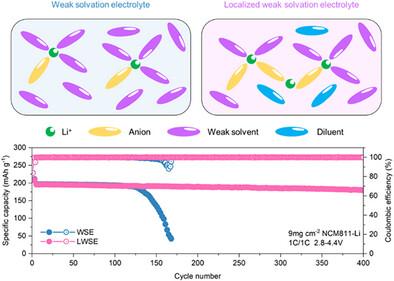实用锂金属电池用醚基局部弱溶剂化液体电解质的合理设计
IF 19
1区 材料科学
Q1 CHEMISTRY, MULTIDISCIPLINARY
引用次数: 0
摘要
虽然局部高浓度电解质(LHCEs)与最先进的高压阴极和锂金属阳极具有兼容性,但它们的实际实施受到氟化稀释剂体积分数过高和离子电导率不理想的阻碍。本文提出了一种局部弱溶剂化策略,以保持电极界面的稳定性,同时降低氟化稀释剂的含量。具体来说,乙二醇二丁基醚(DBE)由于其空间位阻效应而被确定为弱配位溶剂,在降低盐浓度时优先促进接触离子对的形成。此外,非配位(三氟甲基)环己烷(TFMH)稀释剂协同增强阴离子-阳离子相互作用,同时保持剩余的游离溶剂分子作为离子转运位点。得益于这种合理的电解质设计,9 mg cm - 2 NCM811-Li电池在4.4 V截止电压下表现出优异的循环稳定性,在400次循环中实现了91.3%的容量保持率和99.9%的平均库仑效率。值得注意的是,即使在使用高阴极负载(21 mg cm−2)和超薄锂金属阳极(50µm)的实际条件下,NCM811-Li全电池也能保持160次循环的稳定运行。本文章由计算机程序翻译,如有差异,请以英文原文为准。

Rational Design of Ether-Based Localized Weak Solvation Liquid Electrolyte for Practical Lithium Metal Batteries
Although localized high concentration electrolytes (LHCEs) exhibit compatibility with state-of-the-art high-voltage cathodes and lithium metal anodes, their practical implementation is hindered by the excessive volume fraction of fluorinated diluents and suboptimal ionic conductivity. Herein, a localized weak solvation strategy is proposed to preserve electrode interfacial stability while reducing fluorinated diluent content. Specifically, ethylene glycol dibutyl ether (DBE) is identified as a weakly coordinating solvent due to its steric hindrance effect, which preferentially facilitates contact ion pair formation at reduced salt concentrations. Furthermore, the non-coordinating (trifluoromethyl) cyclohexane (TFMH) diluent synergistically enhances anion-cation interactions while maintaining residual free solvent molecules as ion transport sites. Benefiting from this rational electrolyte design, the 9 mg cm−2 NCM811-Li cell demonstrates exceptional cycling stability under 4.4 V cutoff voltage, achieving 91.3% capacity retention and 99.9% average Coulombic efficiency over 400 cycles. Remarkably, even under practical conditions employing a high cathode loading (21 mg cm−2) and ultrathin Li metal anode (50 µm), the NCM811-Li full cell maintains stable operation for 160 cycles.
求助全文
通过发布文献求助,成功后即可免费获取论文全文。
去求助
来源期刊

Advanced Functional Materials
工程技术-材料科学:综合
CiteScore
29.50
自引率
4.20%
发文量
2086
审稿时长
2.1 months
期刊介绍:
Firmly established as a top-tier materials science journal, Advanced Functional Materials reports breakthrough research in all aspects of materials science, including nanotechnology, chemistry, physics, and biology every week.
Advanced Functional Materials is known for its rapid and fair peer review, quality content, and high impact, making it the first choice of the international materials science community.
 求助内容:
求助内容: 应助结果提醒方式:
应助结果提醒方式:


